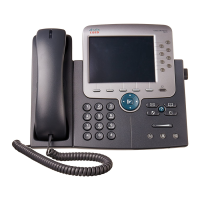1-5
Cisco Unified IP Phone 7975G Administration Guide for Cisco Unified Communications Manager 6.0
OL-12642-01
Chapter 1 An Overview of the Cisco Unified IP Phone
What Networking Protocols Are Used?
IEEE 802.1X The IEEE 802.1X standard defines a
client-server-based access control
and authentication protocol that
restricts unauthorized clients from
connecting to a LAN through
publicly accessible ports.
Until the client is authenticated,
802.1X access control allows only
Extensible Authentication Protocol
over LAN (EAPOL) traffic through
the port to which the client is
connected. After authentication is
successful, normal traffic can pass
through the port.
The Cisco Unified IP Phone
implements the IEEE 802.1X
standard by providing support for the
EAP-MD5 option for 802.1X
authentication.
When 802.1X authentication is
enabled on the phone, you should
disable the PC port and voice VLAN.
Refer to the
“Supporting 802.1X
Authentication on Cisco Unified IP
Phones” section on page 1-16 for
additional information.
Internet Protocol (IP) IP is a messaging protocol that
addresses and sends packets across
the network.
To communicate using IP, network
devices must have an assigned IP
address, subnet, and gateway.
IP addresses, subnets, and gateways
identifications are automatically
assigned if you are using the Cisco
Unified
IP Phone with Dynamic Host
Configuration Protocol (DHCP). If
you are not using DHCP, you must
manually assign these properties to
each phone locally.
Cisco Peer to Peer
Distribution Protocol
(CPPDP)
CPPDP is a Cisco proprietary
protocol used to form a peer to peer
hierarchy of devices. CPPDP is also
used to copy firmware or other files
from peer devices to neighboring
devices.
CPPDP is used by the Peer Firmware
Sharing feature.
Real-Time Control
Protocol (RTCP)
RTCP works with Real-Time
Transport Protocol (RTP) to provide
QoS data (such as jitter, latency, and
round trip delay) on RTP streams.
RTCP is disabled by default, but you
can enable it on a per phone basis
using Cisco
Unified
Communications Manager.
For more information, see the
“Network Configuration” section on
page 4-29.
Real-Time Transport
Protocol (RTP)
RTP is a standard protocol for
transporting real-time data, such as
interactive voice and video, over data
networks.
Cisco Unified IP Phones use the RTP
protocol to send and receive
real-time voice traffic from other
phones and gateways.
Table 1-1 Supported Networking Protocols on the Cisco Unified IP Phone (continued)
Networking Protocol Purpose Usage Notes

